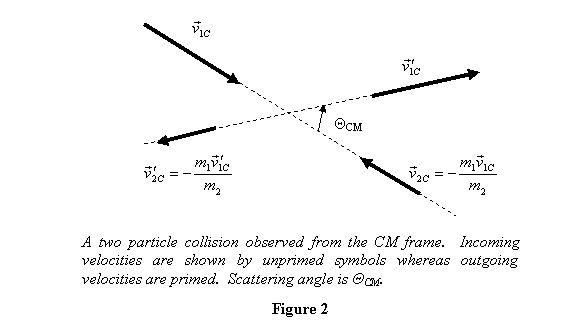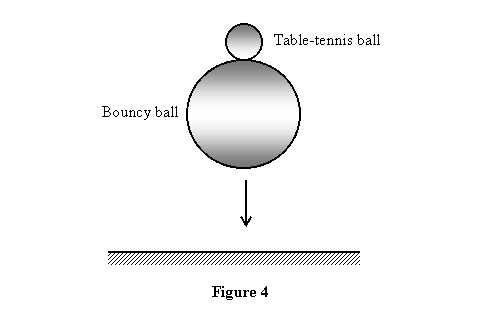As
the first example, let us consider two particles of masses m1 and m2 moving
with velocities  ,
respectively, colliding, getting stuck together to make
a particle of mass (m1 +m2 ) that
moves with velocity
,
respectively, colliding, getting stuck together to make
a particle of mass (m1 +m2 ) that
moves with velocity  .
In the process energy ΔE is released. Then
moment conservation tells us
.
In the process energy ΔE is released. Then
moment conservation tells us

and balancing the energy gives

Notice that we have added to ΔE to the
left-hand side so that the total final kinetic energy
is the sum of the total initial kinetic energy and the
energy added to the system. Substituting for  from
the momentum conservation equation in the energy equation,
we get
from
the momentum conservation equation in the energy equation,
we get

which on simplification gives

The left-hand side of the equation above is definitely
positive. On the other hand, the right-hand side is negative
if ΔE > 0 , i.e., the final kinetic
energy is larger than the initial kinetic energy. So
this reaction will not be possible if it is exothermic,
i.e., some energy is generated and added to the initial
kinetic energy. Thus two atoms colliding in free space
will not combine to form a molecule (in which process
the energy is usually released). However if energy is
taken away from the system, i.e. ΔE < 0,
then the reaction is possible. This is the information
we have got purely on the basis of conservation laws.
We now go on to discuss collisions as described with
respect to the CM. We will see that this gives us a lot
of insight into the collision problem.
As we had stated earlier, the conservation of momentum
implies that the centre of mass moves with a constant
velocity when there is no external force on the particles.
Thus if we attach a frame to the CM, it will also move
with constant velocity and will be an initial frame of
reference. Let us call this the CM frame. Since it is
an inertial frame, we can equally well describe a collision
process is a CM frame. Observing a collision from the
CM frame gives us the biggest advantage that the sum
of the momenta (the total momentum) is always zero in
this frame. In this lecture we will be focusing on two
particle collisions as described from the CM frame. We
will see that because of the total momentum being zero,
description of a collision in this frame becomes simpler.
In coming lectures we will see that CM provides a convenient
origin for studying rotational motion also.
For now, let us look at the two particles collision. As
stated above, in the CM frame the total momentum is always
zero because in this frame the CM does not move. So that
the velocities of two particles in the CM frame are always
in the direction opposite to each other. Further the
motion remains confined to a plane formed by the lines
representing the initial and the final velocities directions
(keep in mind that the velocities of the two particles
at any instant are along the same line though opposite
in direction). Thus in the CM frame a collision looks
as shown in figure 2.

In figure 2 two particles with masses m1 and m2 and
velocities  and
and  are
coming in for a collision; they collide and particle 1 goes
out with velocity
are
coming in for a collision; they collide and particle 1 goes
out with velocity  and
particle 2 with
and
particle 2 with  .
In the process particle 1 gets
deflected by an angle ΘCM. As stated earlier,
even in 2d there are four unknowns: two components
of
.
In the process particle 1 gets
deflected by an angle ΘCM. As stated earlier,
even in 2d there are four unknowns: two components
of  and
two of
and
two of  to
be obtained but only three equations- one
for energy conservation and two for momentum
conservation. So the problem cannot be solved
fully by using conservation principle only.
However, if the interaction is known, then ΘCM and both the velocities
after collision can in principle be calculated. Let
us now see how much can we learn about the motion
after collision applying only the conservation principles.
We will be discussing both the elastic and inelastic
collisions. Recall that if the kinetic energy remains
unchanged in a collision, the collision is elastic;
on the other hand, if the energy is lost the collision
is inelastic.
to
be obtained but only three equations- one
for energy conservation and two for momentum
conservation. So the problem cannot be solved
fully by using conservation principle only.
However, if the interaction is known, then ΘCM and both the velocities
after collision can in principle be calculated. Let
us now see how much can we learn about the motion
after collision applying only the conservation principles.
We will be discussing both the elastic and inelastic
collisions. Recall that if the kinetic energy remains
unchanged in a collision, the collision is elastic;
on the other hand, if the energy is lost the collision
is inelastic.
Let us first focus on an elastic collision and analyze
it in the CM frame. As pointed out earlier, the velocities
of the two particles before and after collision are opposite
to each other. Thus the relationship between the magnitudes
v1C
, v2C , v'1C and v'2C of
the velocities is



Substituting for  and
and  from
the first two equations in the last one we get
from
the first two equations in the last one we get

Thus the velocity vectors of both particles just rotate
but do not change in magnitude as the partial move out
after collision. You have learnt in previous classes
that in an elastic collision the magnitude of the relative
velocity of one particle with respect to the other remains
unchanged during the collision. In one dimension it means
that the speed of approach of two particles is the same
as their speed of separation. Let us now see how it follows
directly from the conservation principles.
As we have derived above,  in
an elastic collision. If the velocities of the two particles
are
in
an elastic collision. If the velocities of the two particles
are  ,
respectively, in the ground frame, then
,
respectively, in the ground frame, then

Similar relationships hold for the velocities after collision
i.e.

Using these relationships we find that

Similarly, we have

Thus we see that in an elastic collision

We have shown that the magnitude of relative velocity
of one particle with respect to other remains the same
in an elastic collision.
To see the dramatic effects of a nearly elastic collision,
take a table-tennis ball (very small mass m),
put it on a large bouncy ball of mass M (M >> m) ,
and drop them from a height (see figure 4) on a hard
floor. You will see that the table-tennis ball bounces
back really high after the balls hit the ground. Can
you work how high will it go if the balls are dropped
from a height h? Assume that no energy is lost.
